 Last additions Last additions |

Leis on the bow endpieces (Manu ihu).Jun 15, 2007
|
|

BowJun 15, 2007
|
|

Jun 15, 2007
|
|

First time that I've gotten this close to Hawaii's most famous canoe.Jun 15, 2007
|
|

The tour group was split into two. One group here was at the stern, listening to a talk by Kanako Uchino, a Japanese crew member.Jun 15, 2007
|
|

The other group was at the bow listening to a talk by another crew member.Jun 15, 2007
|
|

We were then allowed to enter the pier where Hokule'a was docked.Jun 15, 2007
|
|

Hokule'aJun 15, 2007
|
|

"You don't need muscle to do it. It's more mind-oriented..."Jun 15, 2007
|
|
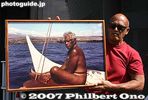
He showed various pictures and gave an overview of some basic concepts.Jun 15, 2007
|
|

He showed sample parts of the boat.Jun 15, 2007
|
|

Like at its other stops in Japan, Hokule'a offered free onboard canoe tours to the public during its one-week stay in Yokohama. A reservation ticket (seiriken) had to be obtained beforehand. (I got one at 1:30 pm on June 11, 2007.)We could see the top deck, rudder, masts, cramped sleeping quarters, food pantry, and more of this legendary canoe named after a star named Hokulea in Hawaiian. Entry to Hokule'a canoe tour on June 11, 2007.Jun 15, 2007
|
|

First we were given life vests. The tour started with an illustrated talk by a man named Kimo.Jun 15, 2007
|
|

Hokule'a tour guests walk on the dock to the boat. The canoe is little over 62 feet long. They only referred to the sun, moon, the stars, and ocean waves to navigate through the vast Pacific Ocean or Polynesia. This is called celestial navigation.Jun 15, 2007
|
|

This was during the 2 pm - 4 pm tour, and by 2:20 pm, the Hokule'a canoe tour reception desk says tours are all full. ホクレア号乗船見学会Jun 15, 2007
|
|

Hokule'a in Yokohama for the first time. This boat was first launched on March 8, 1975. It has become part of Hawaii's modern soul and spirit.Jun 15, 2007
|
|

What makes this canoe so special and famous is that it was used to sail from Hawaii to Tahiti (and many other places) without any modern navigational instruments.Jun 15, 2007
|
|

Escort ship Kama HeleJun 15, 2007
|
|

Pukari Sanbashi Pier in Minato Mirai, Yokohama, Japan. Hokule'a docked on the left (arrived June 9, 2007).Jun 15, 2007
|
|

Hokule'a and Kama Hele in Yokohama, June 10, 2007Jun 14, 2007
|
|

Pukari Sanbashi Pier. Hokule'a can be seen on the left. On the right is another pier for sightseeing boats. The building in the middle is a resthouse.Jun 14, 2007
|
|

Hokule'a at YokohamaJun 14, 2007
|
|

Jun 14, 2007
|
|
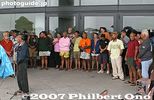
Hokule'a crew on stage.Jun 14, 2007
|
|
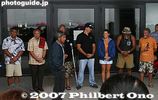
Nainoa introduces the rest of the crew and future Hokule'a captains being groomed to take over.Jun 14, 2007
|
|
|

Nainoa Thompson gave a touching speech about Japan-Hawaii friendship, their rediscovery of Japan ("Japan is not just Tokyo"), and Hokule'a's mission.Jun 14, 2007
|
|

Jun 14, 2007
|
|

Jun 14, 2007
|
|

Jun 14, 2007
|
|

In return, the crew performs the haka dance.Jun 14, 2007
|
|

Jun 14, 2007
|
|

A small crowd watch the welcome ceremony. パシフィコ横浜国立大ホール前テラスJun 14, 2007
|
|

Nainoa Thompson gives a thank you speech with Hokule'a's captains.Jun 14, 2007
|
|

Jun 14, 2007
|
|

A local taiko troupe give a spectacular performance. 学校法人国際学園 星槎国際高等学校Jun 14, 2007
|
|

Hula dancers watch the ceremonyJun 14, 2007
|
|

Jun 14, 2007
|
|

Captain Blankenfeld receives a gift.Jun 14, 2007
|
|

Jun 14, 2007
|
|

June 10, 2007. A formal welcoming ceremony was held the next day on an outdoor terrace near the pier. Unfortunately, it was a rainy day and attendance was much smaller than the day before. 入港歓迎セレモニーJun 14, 2007
|
|

Jun 14, 2007
|
|

He actually wanted her to keep her magnificant work of art, but she wanted him to have it.Jun 14, 2007
|
|

He folds the sheet neatly and carries it with him to a press conference which he was late in attending. An ideal Goodwill Ambassador.Jun 14, 2007
|
|

The ceremony included hula chanting and dancing.Jun 14, 2007
|
|

He accepts the little girl's impressive gift.Jun 14, 2007
|
|

He poses with the girl.Jun 14, 2007
|
|

I have never seen anyone who shook everybody's hand, signed autographs for everyone, and posed for all photographers. ナイノア・トンプソンJun 14, 2007
|
|

The little girl was in awe and speechless.Jun 14, 2007
|
|

He was so touched and impressed that he gave her a hug.Jun 14, 2007
|
|

This woman put a small necklace on him.Jun 14, 2007
|
|

He never refused to sign an autograph.Jun 14, 2007
|
|

Finally at the end, a little girl's artwork on a sheet of cloth catches his eye.Jun 14, 2007
|
|

He never refused to shake a hand.Jun 14, 2007
|
|

Plus a handshake for this little guy...Jun 14, 2007
|
|

Jun 14, 2007
|
|

Jun 14, 2007
|
|

"Here you go!"Jun 14, 2007
|
|

He shook hands with EVERYBODY and ANYBODY.Jun 14, 2007
|
|

The crowd was thrilled to be so close to this man full of aloha.Jun 14, 2007
|
|

Nainoa has a habit of crouching on his knees so he can use his knee as a backing to sign autographs.Jun 14, 2007
|
|

People line up to shake Nainoa's hand or get his autograph or take his picture.Jun 14, 2007
|
|

Jun 14, 2007
|
|

Nainoa ThompsonJun 14, 2007
|
|

Captain Blankenfeld who piloted the canoe to Yokohama.Jun 14, 2007
|
|

Nainoa shook every single hand.Jun 14, 2007
|
|

Jun 14, 2007
|
|

Finally, Nainoa Thompson makes his way from the pier and into the crowd.Jun 14, 2007
|
|

All the crew members met applause and handshakes.Jun 14, 2007
|
|

All the crew members were very friendly to all. This is Captain/Navigator Chadd Paishon.Jun 14, 2007
|
|

Arrival ceremony ends and people start to leave the pier.Jun 14, 2007
|
|

KimoJun 14, 2007
|
|

Nainoa Thompson and other crew members get off the boat. Nainoa was on board, but was not part of the crew who brought the canoe to Yokohama.Jun 14, 2007
|
|

Future Hokule'a Captain, Ka'iu Murphy.Jun 14, 2007
|
|
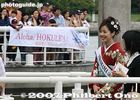
Miss Yokohama also took part in the arrival ceremonies.Jun 14, 2007
|
|

Conch shell blowerJun 14, 2007
|
|

Crew members hug each other.Jun 14, 2007
|
|

Jun 14, 2007
|
|

Former Yokozuna Akebono (blue shirt) and his family were also on the pier. (Wife and daughter in orange.)Jun 14, 2007
|
|

Hokule'a crew dance on the canoe.Jun 14, 2007
|
|

Royal Order of Kamehameha I leave the pier.Jun 14, 2007
|
|

Royal Order of Kamehameha IJun 14, 2007
|
|

Royal Order of Kamehameha I wear red and gold capes.Jun 14, 2007
|
|

Hula dancersJun 14, 2007
|
|

Hula dancers take part in arrival ceremonies.Jun 14, 2007
|
|

Jun 14, 2007
|
|

Captain Bruce Blankenfeld places a lei on the bow.Jun 14, 2007
|
|

Crowd on the waterfront near the pier.Jun 14, 2007
|
|

Hokule'a arrival ceremoniesJun 14, 2007
|
|

Hokule'a crew membersJun 14, 2007
|
|

The Royal Order of Kamehameha I take part in arrival ceremonies. 入港式Jun 14, 2007
|
|

Welcome banner from YanmarJun 14, 2007
|
|

Koinobori carp streamers adorn Hokule'a. A great Japanese touch.Jun 14, 2007
|
|

Jun 14, 2007
|
|

Escort ship Kama Hele flying the Japanese, Hawaiian, and Yanmar flags at Yokohama.Jun 14, 2007
|
|

Pulling Hawaii's most famous canoe to dock.Jun 14, 2007
|
|

Under overcast skies, Hokule'a docks.Jun 14, 2007
|
|

Escort ship (powered by a Yanmar engine) Kama Hele also docks soon afterward.Jun 14, 2007
|
|

Jun 14, 2007
|
|

Hula dancersJun 14, 2007
|
|

A rope is thrown to the dock from Hokule'a.Jun 14, 2007
|
|

Hokule'a arrives right on schedule at 11 am on June 9, 2007. Yokohama is its last stop.Jun 14, 2007
|
|

Conch shell blowers signal the canoe's arrival.Jun 14, 2007
|
|

Hokule'a nears the dock.Jun 14, 2007
|
|

Nearing Pukari Sanbashi Pier. The question was, which side of the pier would it dock? (Was going the other side so I rushed over to the other side.)Jun 14, 2007
|
|

Hokule'a and Yokohama Bay Bridge in the background.Jun 14, 2007
|
|

One sail unraveled.Jun 14, 2007
|
|

They wanted to prove that the original native Hawaiians were able to sail between Tahiti to Hawaii on purpose, and that they did not land on Hawaii by accident.Jun 14, 2007
|
|

They only referred to the sun, moon, the stars, and ocean waves to navigate through the vast Pacific Ocean or Polynesia. This is called celestial navigation. Extremely few people can do this, and the Hawaiians are learning this skill of long-ago.Jun 14, 2007
|
|

Hokule'a already in sight well before 11 am when it was scheduled to dock.Jun 14, 2007
|
|

Hokule'a and escort ship Kama Hele. What makes this canoe so special and famous is that it was used to sail from Hawaii to Tahiti (and many other places) without any modern navigational instruments.Jun 14, 2007
|
|

People crowd the waterfront near Pukari Sanbashi Pier.Jun 14, 2007
|
|

People crowd the waterfront near Pukari Sanbashi Pier.Jun 14, 2007
|
|

June 9, 2007. Hula dancers rush to Pukari Sanbashi Pier where the Hokule'a canoe is to dock. ぷかりさん橋Jun 14, 2007
|
|

A crowd of a few hundred on hand to greet Hokule'a's arrival.Jun 14, 2007
|
|

9th panel showing song monuments for Verses 4-6Jun 06, 2007
|
|

13th panel showing photos of Kyoto University Rowing Club rowing around Lake Biwa in Aug. 2006.Jun 06, 2007
|
|

3rd panel showing Verse 2 (Omatsu or Omi-Maiko)Jun 06, 2007
|
|

One half of the exhibition. It is similar to the exhibition held here a year before, but many new photos have been added. They include photos of the Kyoto Univ. Rowing Club and our activities in the past year.Jun 06, 2007
|
|
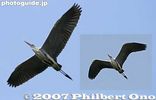
These heron birds make nests in Genkyu-en's trees.Jun 05, 2007
|
|
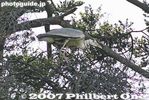
Nesting herons can be quite noisy in spring.Jun 05, 2007
|
|

A heron bringing back a branch to make a nest at Genkyuen Garden in Hikone, Shiga.Jun 05, 2007
|
|

Jun 05, 2007
|
|

Jun 05, 2007
|
|

Jun 05, 2007
|
|

Jun 05, 2007
|
|

Jun 05, 2007
|
|

Jun 05, 2007
|
|

Hikone Castle Moat Boat Ride PosterJun 05, 2007
|
|

Boat landing is near the entrance to Genkyu-en Garden.Jun 05, 2007
|
|

End of the 50-min. ride. It was pleasant, and highly recommended. Boat landing for the Hikone-jo Ohori Meguri boat ride is near the entrance to Genkyu-en Garden.Jun 05, 2007
|
|

Jun 05, 2007
|
|

Jun 05, 2007
|
|

The second yakata-bune boat. They referred to old drawings, etc., and carefully built the boat to resemble Edo-Era yakata-bune.Jun 05, 2007
|
|

Ready to pass under Otemon Bridge again.Jun 05, 2007
|
|
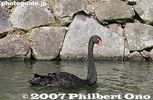
Black swan in Hikone Castle's moat, a gift from Mito in Ibraraki Prefecture.Jun 05, 2007
|
|

End of the moat. The moat once was connected to Lake Biwa, but not anymore since the lake's water level does not match the moat's water level.Jun 05, 2007
|
|

End of the moat. Lake Biwa is right beyond. This is where we make a U-turn.Jun 05, 2007
|
|

Jun 05, 2007
|
|

Castle towerJun 05, 2007
|
|

The boat includes a narrator who explains about the castle and moat and swans.Jun 05, 2007
|
|

Castle tower as seen from the moatJun 05, 2007
|
|

Jun 05, 2007
|
|

The next Otemon BridgeJun 05, 2007
|
|

Jun 05, 2007
|
|

Jun 05, 2007
|
|

A few of the stones in the wall are black. Some say those stones might have come from Azuchi Castle after it was burned to the ground.Jun 05, 2007
|
|

Otemon BridgeJun 05, 2007
|
|
|
|

The boat is powered by very silent, battery-powered outboard motors.Jun 05, 2007
|
|

Otemon BridgeJun 05, 2007
|
|

Jun 05, 2007
|
|

Going under Otemon Bridge. Wooden boards protect the bridge posts from the boat.Jun 05, 2007
|
|

Heading toward Otemon Gate/BridgeJun 05, 2007
|
|

Inside Japanese-style yakata-bune boat. Seats 11 people on tatami mats. The roof is very low. 彦根城お堀めぐりJun 05, 2007
|
|

Koedo Hikone NPO started operating "yakata-bune" Japanese-style boats in the moats of Hikone Castle as a tourist attraction for the castle's 400th anniversary in 2007. They operate 6 rides per day around the castle, taking 50 min.Boat landing for the Hikone-jo Ohori Meguri boat ride. Near the entrance to Genkyu-en Garden. They operate "yakata-bune" Japanese-style boats as a tourist attraction.Jun 05, 2007
|
|

It certainly gives you a different perspective of the castle as you see the moat, castle tower, and bridges from the water. The ride costs 1,200 yen.Jun 05, 2007
|
|

Pit for offering white stonesJun 04, 2007
|
|

Walk around this post and another 50 meters away 100 times to eliminate your troubles.Jun 04, 2007
|
|

White stones (which you can buy) written with your wishes or prayers.Jun 04, 2007
|
|

View from Tarobogu.Jun 04, 2007
|
|

Wedded Rock sacred ropeJun 04, 2007
|
|

Of course, the Wedded Rocks is also good for married couples to maintain a good and happy marriage. Meoto-iwa 夫婦岩Jun 04, 2007
|
|

Haiden ceremony hall 拝殿Jun 04, 2007
|
|

Tarobo-gu is a shrine complex on a small mountain, featuring grand views of Yokaichi and a pair of Wedded Rocks. It is 1.1 km from Tarobogu-mae Station on the Ohmi Railway Line. The shrine's real name is Aga Jinja 阿賀神社. [url=http://goo.gl/mapMap of Tarobo-gu. You can drive up halfway up the mountain (called Mitsukuriyama 箕作山) which is 350 meters high. If you don't have a car, climb over 700 steps to reach the shrine's main hall.Jun 04, 2007
|
|

Entrance to the shrine.Jun 04, 2007
|
|

Jun 03, 2007
|
|

Jun 03, 2007
|
|

Jun 03, 2007
|
|

Jun 03, 2007
|
|

Jun 03, 2007
|
|

Jun 03, 2007
|
|

Medium-size kites entered in a kite-flying contest.Jun 03, 2007
|
|

Carrying out bamboo. Many people left the festival after the kite crash.Jun 03, 2007
|
|

Jun 03, 2007
|
|

As I predicted again, they started disassembling the kite so they could roll (crumple) it up and carry it out. The kite was not flown again for this festival. It was to be its final flight since it will be replaced next year.Jun 03, 2007
|
|

A closer look at the accident scene. The kite suffered significant damage, and it took about 20 days to repair.Jun 03, 2007
|
|

No way would this guy be able to pull the kite out of this one...Jun 03, 2007
|
|

Stack of cut bamboo.Jun 03, 2007
|
|

The kite strings were too tangled in the bamboo.Jun 03, 2007
|
|

How he wished that he could just pull the strings to drag the kite out.Jun 03, 2007
|
|

A small clearing was made around the kite.Jun 03, 2007
|
|

Members of the giant kite preservation society look on as the disappointing and heartbreaking situation is assessed.Jun 03, 2007
|
|

As I expected, they soon started cutting down the bamboo.Jun 03, 2007
|
|

Hanging on to the strings...Jun 03, 2007
|
|

"So how does it look?" "It looks pretty bad, boss."Jun 03, 2007
|
|

All we could see were the kite strings.Jun 03, 2007
|
|

This was the 2nd time in three years for the giant kite to meet a major accident. In 2005, the kite broke in half in the sky and crashed into a crowd of people below.Jun 03, 2007
|
|

The sign says "Arigato gozaimasu" (Thank you). I guess the bamboo was hungry for a giant kite.Jun 03, 2007
|
|

The giant kite was swallowed whole by the bamboo trees. No one was hurt. Also see my YouTube video here. 大凧が竹やぶに落下Jun 03, 2007
|
|

At slightly past noon with medium-force winds, the giant kite is launched. The kite immediately went straight up. The giant kite is 13 meters high and 12 meters wide, and weighs 700 kg.Jun 03, 2007
|
|

May 27, 2007 was a bad day for giant kite flying in Yokaichi, as the giant kite crashes head-first into a bamboo grove on its first and last flight during the Yokaichi Giant Kite Festival.Jun 03, 2007
|
|

Then it suddenly dove straight down and crashed head-first into the bamboo grove. Ironically, the blue banner on the left says, "Ganbatte" (Do your best).Jun 03, 2007
|
|

It flew very high, up to about 150 meters, then veered to the right, over our heads.Jun 03, 2007
|
|

12th panel showing photos of our song-related activities.May 30, 2007
|
|

Last panel showing news articles and Web pages and people singing the song.May 30, 2007
|
|

11th panel showing photos of our song-related activities. Our first public performance, appearance on NHK Nodo Jiman, CD recording, etc.May 30, 2007
|
|

10th panel showing Oguchi Taro song monument and his grave and house in Okaya, Nagano.May 30, 2007
|
|

8th panel showing song monuments for Verses 1-3May 30, 2007
|
|

7th panel showing Verse 6 (Chomeiji)May 30, 2007
|
|

6th panel showing Verse 5 (Hikone)May 30, 2007
|
|

4th panel showing Verse 3 (Imazu)May 30, 2007
|
|

5th panel showing Verse 4 (Chikubushima)May 30, 2007
|
|

1st panel explaining about the exhibition and English song. This exhibition coincides with the June 16, 2007 release of our Lake Biwa Rowing Song CD.May 30, 2007
|
|

2nd panel showing Verse 1 (Otsu)May 30, 2007
|
|

2nd Imazu Exhibition, May 30 - July 1, 2007 at Biwako Shuko no Uta Shiryokan, Takashima, Shiga. This was the second time to have an exhibition here. Photo exhibition poster.May 30, 2007
|
|

Fourth panel showing all the song monuments in Shiga and Okaya, Nagano.May 30, 2007
|
|

Fifth and final panel showing photos of our song-related activities.May 30, 2007
|
|

Third panel explaining Verses 5 and 6.May 30, 2007
|
|

Second panel explaining Verses 3 and 4.May 30, 2007
|
|

2nd floor gallery in Yokaichi Public Library. This floor is also like a coffee shop.May 30, 2007
|
|
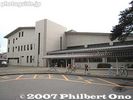
Yokaichi Public Library, near Yokaichi Station. 東近江市 八日市図書館May 30, 2007
|
|

First panel explaining Verses 1 and 2, Yokaichi Public Library 2nd floor galleryMay 30, 2007
|
|

Yokaichi Exhibition, May 9-27, 2007 at Yokaichi Public Library, HigashiOmi, Shiga. Photo exhibition poster.May 30, 2007
|
|

One float (from Shimizu-cho) provided an explanation about the float in English.May 06, 2007
|
|

Float from Shimizu-cho with a panel explaining about the float in both English and Japanese. Carved panels depicting the Twenty-four Paragons of Filial Piety by famed Suwa woodcarver, Tatekawa Washirō and a wave design drawn by Kyōto artist Mankō are..Constructed in 1825 (Bunsei 8). Carved panels depicting the Twenty-four Paragons of Filial Piety by famed Suwa woodcarver, Tatekawa Washirō and a wave design drawn by Kyōto artist Mankō are of great beauty. The gold leaf and lacquer adorning this hikiyama was applied by a Shimizu-chō resident artisan employing the utmost skill and devotion.
May 06, 2007
|
|

Exhibition roomMay 03, 2007
|
|

Communal toiletMay 03, 2007
|
|

May 03, 2007
|
|

In front of the fire watchtower is this open area designed as a fire break to prevent any fires from spreading further. It is also a gathering place with food stalls.May 03, 2007
|
|

Video theaterMay 03, 2007
|
|

Nagaya longhouseMay 03, 2007
|
|

Cross section of a typical Nagaya longhouse apartment. It was a single room whose size was about 6 tatami mats.May 03, 2007
|
|

Cross section of a typical Nagaya longhouse apartment. The saw on the wall indicates that the resident was a log cutter. The area was close to Kiba where they processed logs.May 03, 2007
|
|

Clothes line for laundry.May 03, 2007
|
|

River boat taxiMay 03, 2007
|
|

Fire watchtower on the left, and boat operator's house on the right. 船宿升田屋と相模屋May 03, 2007
|
|

Cross section of a typical Nagaya longhouse apartment.May 03, 2007
|
|

Boat operator's house 船宿升田屋と相模屋May 03, 2007
|
|

Rice vendor. A small, wooden square box was used to measure the volume of rice to sell to a customer. 舂米屋職人May 03, 2007
|
|

River boat taxiMay 03, 2007
|
|

Machikido town gate made of wood. This gate marked the boundary between towns. It could also be closed. 町木戸May 03, 2007
|
|

Bales of rice inside the rice storehouse.May 03, 2007
|
|

Back room of the vegetable seller.May 03, 2007
|
|

Main street with shops.May 03, 2007
|
|

May 03, 2007
|
|

Vegetable seller. 八百屋の八百新May 03, 2007
|
|

Rice storehouseMay 03, 2007
|
|

The lighting inside the museum also changes to reflect the time of day. This is night time.May 03, 2007
|
|

Cat on the roof. Meow is what you first hear in the museum. Its name is "Mamesuke." Actually a robot cat whose head can move up and down.May 03, 2007
|
|

Day timeMay 03, 2007
|
|

After you enter the exhibition area, first you see drawings of famous people from Fukagawa.May 03, 2007
|
|

Fukagawa-Edo MuseumMay 03, 2007
|
|

Then you see a dramatic bird's eye view of the recreated neighborhood of Sagacho, Fukagawa. The entire neighborhood is indoors.May 03, 2007
|
|

Road to the Fukagawa-Edo Museum, near Kiyosumi-Shirakawa Station.May 03, 2007
|
|

May 03, 2007
|
|

Stone lanternMay 03, 2007
|
|

Pine tree and RyoteiMay 03, 2007
|
|

Pine tree and RyoteiMay 03, 2007
|
|

Stone pagoda on island named MatsushimaMay 03, 2007
|
|

May 03, 2007
|
|

Kasa-tei 傘亭May 03, 2007
|
|
| 71466 files on 284 page(s) |
 |
 |
231 |  |
 |
|